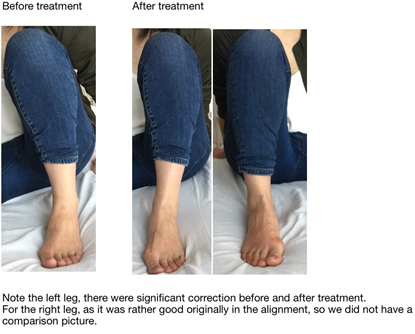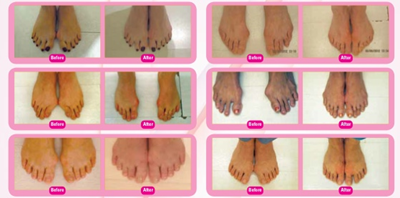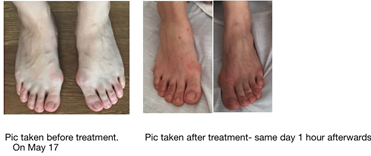Case Report
Volume 2 Issue 4 - 2018
A Case Report on Non-Surgical Approach to Correction of Hallux Valgus
MCSP (UK) RP (HK) RP (Australia) Body Rejuvenation Expert
*Corresponding Author: Milly Ng, MCSP (UK) RP (HK) RP (Australia) Body Rejuvenation Expert.
Received: June 18, 2018; Published: September 06, 2018
Abstract
The author has successfully corrected more than 300 cases of Hallux Valgus using this procedure. It is much less traumatic, much less time consuming and most of all, in 90% of the cases, the patient can be passively positioned, then actively maintained in a non-Hallux Valgus (normal alignment) pose within 30 mins of the procedure which is a strong indication it is not a bony overgrowth as most people thought. But simply a subluxation\dislocation of the 1st metatarsal phalangeal joint. Hence by reduction of the dislocation and strengthening of the muscles involved, most of the patients would be able to gain a corrected alignment within 10 sessions/10 days of the procedure.
Keywords: Hallux Valgus; Non-surgical; Subluxation/Dislocation; Muscle control
Introduction
Background
The procedure involved
The procedure involved
- The use of the correct medical device- Micro current electrical stimulation of one millionth of an ampere current developed by Dr. Thomas Wing as distinguished from the usual TENS device that frequently used for suppression of pain. Micro current is doing the opposite, it does not suppress but activate, energize. It is proven that it can increase the ATP formation by 500%.
- The understanding of the patient to the procedure is very important. The viability and the concept behind what has been happening, why would people developed Bunion, how to avoid getting it again. Showing in video both testimonial and also how other people with similar deformity can get corrected. To give them confidence that it is authentic and absolutely correctable.
- The practitioner’s rapport with the patient, his perseverance and firm attitude and can-do manner all counts into the success of the procedure though of course his in depth knowledge in the foot and lower limbs anatomy and kinesiology all played a very important part in the final outcome is for sure.
Purpose
To introduce a better alternative to the surgical approach of treating Hallux Valgus.
To introduce a better alternative to the surgical approach of treating Hallux Valgus.
Significance of the study
A reflection of our approach/mindset to medical science. Are there other ways in addition to medicine or surgery?
A reflection of our approach/mindset to medical science. Are there other ways in addition to medicine or surgery?
Materials and Methods
Micro current device manufactured by the Monad Corporation. (Not any Micro current device in the market especially not a combo, ie. not a device with Micro current and milli current or ultrasound, etc.). Recording material showing before and after treatment result- photo and video and let patient keep a record of the everyday progress so she can go back to review noting the minor details in the progress.
NB: it is certainly not an easy simple procedure. It involves a lot of mental work to correct a deformity that has been with the patient for 20-30 years, sometimes even 40 years. The patient has to correct/discard certain bad habit and relearn how to correctly use/relax certain muscles and co-ordinate them at the same time.
It is very much like playing a new song with a piano or learning a new dance. Repetition of the procedure until it becomes a habit is very important. So without conscious thinking, one can carry it out subconsciously and incorporate it into everyday life. The author finds a replay of the whole procedure right in front of the patient’s eyes will make it much easier to learn and reinforce the muscle memory using the Micro current machine to establish the connection from the brain to the muscle. In addition, as the foot muscle is usually the most distant to the eyes and the brain, learning the procedure bringing it closer in sitting instead of standing seems to make the task easier to learn. This is also a finding of the author in learning this non-surgical approach.
Results and Discussion
It is a 10 sessions/10 day’s procedure and patient should be able to see a significant improvement/correction on the 1st day of the procedure. The subsequent 9 sessions is to reinforce what has been achieved/corrected. Each session takes about one hour to complete.
During these 10 days, patient is strongly suggested to practice the corrected alignment back home not less than twice a day, each practice at least 20 minutes though a lot of patients would practice more than 5 times a day to make it form a habit as soon as possible.
In the above image, most of the cases of the before/after image were taken on the first day of the procedure.
The photo were being taken asking the patient to pose the feet in the corrected alignment after using Micro current to regenerate the soft tissue of the feet including the muscle, ligaments and joint capsule, etc. At the same time, Micro current serves to reconnect the neural pathway of the brain to the feet muscle rendering the patient able to control it the very first time in 10-40 years that they haven’t been used since they developed the Bunion.
Hallux Valgus is not a congenital deformity but a chronic subluxation of the joint due to poor footwear and incorrect walking gait. Being said that, it is also not a bony overgrowth as most surgeons thought who contemplate to saw away the excess bone for cosmetic purpose. As a matter of interest, Hallux Valgus seldom exist alone, it usually co-exist with other deformities e.g. hammer toes, flat feet, etc. Hence as a practitioner who correct the Hallux Valgus, we should also correct the associated deformities as well and otherwise the result would not be complete and permanent.
In the following picture, we demonstrate this inter-relationship. If we do not correct the ankle mortise first, it would be very difficult to correct the Hallux Valgus or we can put it this way, the correction would not stay/would not be permanent without fixing the alignment of the ankle mortise.
This can be corrected by training the muscle to come back to life again as seen in the following pic.

Note the left leg, there were significant correction before and after treatment.
For the right leg, as it was rather good originally in the alignment,
so we did not have a comparison picture.
The foot and the ankle as a consequence is being slim up in addition to the correction of Hallux Valgus as seen in the above photo.
Please also note in the following pic, the relation of the ankle to the knee joint and the curvature of the tibia & fibula bone also corrected after the treatment. On Day 5 of the 10 days procedure when the correction is being consolidated, we will start to train the dynamic alignment by training the patient the correct way of walking maintaining the static alignment we have achieved in the last 4 days. We also emphasize calling the big group of muscle (namely the Gluteus, the quadriceps and the calf) into action which due to the patient’s poor walking gait and mal-alignment of the body has become atrophied.
Conclusion
This is not just a non-surgical correction of Hallux Valgus. Since the author developed this non-surgical procedure for Bunion, she has improved it from just achieving a static correction to now a dynamic correction and incorporated into the everyday life. So the patient after this treatment programme would be able to live a life pain free not just at the Bunion but the rest of the weight bearing joints as they are all being aligned/corrected. They have stronger legs, much better circulation therefore much less or zero incidence of leg cramp, seldom or no more sprain ankle. In other words, they are aging gracefully.
What brings about this positive outcome?
- The use of the correct equipment. The author is a specialist on Micro current since 1992. She has tried using a combo and some smaller simpler device not able to bring the same result on the same condition over the same patient. Since the result of the correct machine is instant, so one would be able to discern the difference right away.
- The attitude of the practitioner is very important. He or she has to be very positive that this will work. If the practitioner is not confident in her treatment, the patient would be able to sense it, then it won’t work.
- The participation of the patient is the key issue. If the patient does not concern about the outcome. If he/she just lie there like a dead fish waiting for miracle to happen without putting effort to learn during the procedure nor doing the exercise with all her heart afterwards, then it won’t work. No one can force the patient to recover. So we have to make sure the patient is 100% committed by signing an agreement before starting the procedure. They have to complete the 10 sessions no matter what. There will not be any refund if for whatever reason they cannot complete the 10 sessions. 10 sessions is 10 sessions, no extensions even by the end of the 10 sessions, even they are still unable to achieve the alignment. I realized this time limit is essential which will give them a psychological boost that by Day 7 or Day 8 if they are still lag behind due to (I have no time to practice, I am traveling, I forgot how to do it..... etc.). So by Day 7 or Day 8, they become panic and will practice the whole day going back home then by Day 10, everybody would be very happy.
Are there failure so far?
Yes, two cases.
Yes, two cases.
- A lady in her 70’s with poor balance that she is unable to discontinue her wide base waddling gait though she can achieve the static correction of Bunion.
- A lady from South Africa who had 10 surgeries done to her Bunion in the past 12 months that no doctor would operate further on her. She was presented with a deformity opposite to Hallux Valgus with the big toes sticking out which is impossible to put on shoes. The feet were so swollen and painful to walk with every step. In 5 sessions, we managed to build the adductor Hallucis to correct her deformity but she refused to continue the rest of the treatment as she said she cannot stand the pain.
How to avoid failure?
Careful selection of patients. If you sense that the patient would not be able to commit to 10 sessions and do not have time to practice the exercise, don’t take this patient. He or she must have a burning desire, a strong determination to get better, otherwise drop him out of your list. He would just bring you trouble later on.
Careful selection of patients. If you sense that the patient would not be able to commit to 10 sessions and do not have time to practice the exercise, don’t take this patient. He or she must have a burning desire, a strong determination to get better, otherwise drop him out of your list. He would just bring you trouble later on.
Citation:
Milly Ng. “A Case Report on Non-Surgical Approach to Correction of Hallux Valgus”. Orthopaedic Surgery and Traumatology
2.4 (2018): 373-377.
Copyright: © 2018 Milly Ng. This is an open-access article distributed under the terms of the Creative Commons Attribution License, which permits unrestricted use, distribution, and reproduction in any medium, provided the original author and source are credited.





































 Scientia Ricerca is licensed and content of this site is available under a Creative Commons Attribution 4.0 International License.
Scientia Ricerca is licensed and content of this site is available under a Creative Commons Attribution 4.0 International License.